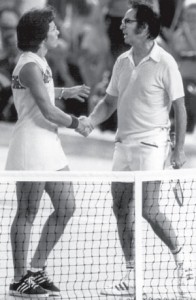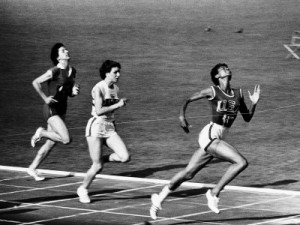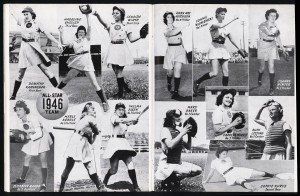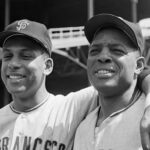Biggest Milestones in U.S. Women’s Sports History
America’s heartbreaking loss to Japan in the Women’s World Cup final, though painful, was hardly a setback for women’s sports in this country. During this summer, the world’s No. 1 team provided enough drama to captivate men and women from coast to coast, drawing large television audiences and even setting a Twitter record of 7,196 tweets per second. Hope Solo and Abby Wambach became household names and served as inspiration for girls who strive to play soccer and other sports at the highest levels. None of it would’ve happened, however, without the following milestones. Each one marked an important moment in not just women’s sports history, but sports history.
1. President Nixon makes Title IX a reality (1972)
Signed into law by the socially moderate President Nixon, Title IX specified that “No person in the United States shall, on the basis of sex, be excluded from participation in, be denied the benefits of, or be subjected to discrimination under any education program or activity receiving Federal financial assistance.” Participation in women’s sports has grown significantly in the decades following its passage, as a 2008 study indicated that women’s college athletics has expanded to 9,101 teams (8.65 per school).
2. Wilma Rudolph wins three gold medals (1960)
Women’s track and field became one of the Olympics’ flagship events thanks to Rudolph, who became the first American woman to secure three gold medals (100m, 200m, 4 x 100m relay) during the 1960 Summer Olympics in Rome. Dubbed “the fastest woman in history,” a worldwide audience was able to witness her blazing speed on television, enabling her popularity to soar. Her impact was especially felt in the US, where a demand for equality was just beginning to manifest.
3. Women’s soccer wins its second World Cup (1999)
This one was extra special because the US was the host country, allowing the women’s soccer team to demonstrate its talent before pro-American home crowds, interest that even surprised the players. Never before had America rallied behind a women’s team in such a manner — most people forgot about the gender distinction and milestones, and just rode the wave of patriotism to the final. That’s when, of course, Brandi Chastain memorably connected on the game-winning penalty kick, ripping off her jersey in exuberance. With 90,185 fans in attendance, it became the most-attended women’s sporting event in history. At the time, it garnered a remarkable 11.4 rating, the most-watched soccer game in US television history and one-tenth of a point higher than the average rating of that summer’s NBA Finals.

The 1973 "Battle of the Sexes" between Billie Jean King and Bobby Riggs helped give women an athletic platform.
4. Billie Jean King defeats Bobby Riggs (1973)
Although Riggs’ chauvinist personality was exaggerated for publicity, he still caught the ire of women whose athletic talent had been belittled by men. After defeating Margaret Court in two sets, he found another taker, King, who agreed to a lucrative financial offer. The second “Battle of the Sexes” occurred in the Astrodome, and King proceeded to make quick work of Riggs, defeating him in straight sets (6-4, 6-3, 6-3). The landmark victory served as proof that women’s tennis deserved recognition as a high-level sport.
5. All-American Girls Professional Baseball League forms (1943)
With the opportunity to finally participate in a league of their own, baseball-loving women from the World War II era played a modified version of the game — a hybrid of baseball and softball — as many major leaguers put their careers on hold to fight for their country. In 1948, when the AAGPBL was essentially in its prime, the 10 teams attracted 910,000 fans and players earned up to $125 per week. The league folded six years later, but was commemorated in the 1992 film A League of Their Own starring Tom Hanks, Rosie O’Donnell, Madonna and Geena Davis.
6. The WNBA tips off (1997)
Backed by the NBA and a television deal with NBC, ESPN, and Lifetime, the WNBA was the first American women’s professional sports league to garner worldwide attention and feature truly big-name players — the 1996 gold medal-winning women’s basketball team consisted of Sheryl Swoops, Lisa Leslie and Rebecca Lobo, the latter two of whom faced off in the league’s very first game. During its inaugural season, more than 50 million viewers watched the games, half of which were males. Currently, the league is in its 15th season, and the young girls who watched in the beginning now comprise the newest generation of stars.
7. Kathrine Switzer becomes first woman to compete in Boston Marathon (1967)
Bobbi Gibb was the first woman to complete the Boston Marathon, but Kathrine Switzer was the first woman to officially compete in it. Entering the race under the gender-neutral name “K.V. Switzer,” she was given a race number and eventually strong resistance from race official Jock Semple, who shouted “Get the hell out of my race and give me those numbers” while attempting to rip off her number as she was running. Fortunately, her boyfriend was there to help fend him off, enabling her to finish the race. Women were allowed to participate in the marathon five years later.
8. Danica Patrick becomes first woman to win IndyCar Race (2008)
Patrick’s promising racing career began with Rookie of the Year honors for both the 2005 IndyCar Series and the 2005 Indianapolis 500 — she led the Indianapolis 500 late and finished in second place. But her first win didn’t come until three years later, when she stole the show at the Indy Japan 300, becoming the first woman to win an Indy race and any major US-sanctioned open-wheel race. She finished the 2008 IndyCar Series in sixth place, her second-highest finish to date.
9. UConn women’s basketball wins 90 in a row (2008-2010)
Just a week after the Huskies passed UCLA’s 88-game winning streak during the early ’70s under legendary head coach John Wooden, they fell to No. 9 Stanford, the team that last beat them two years earlier during the NCAA national semifinals. During the streak, Geno Auriemma’s squad won two national championships, accomplishing back-to-back undefeated seasons. Such dominance is rarely seen in any sport, which is why it’s one of the top sports stories of the millennium.
This article is reprinted with permission from onlinecertificateprograms.org.











